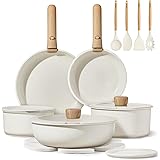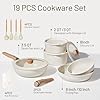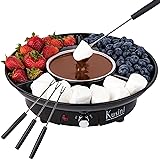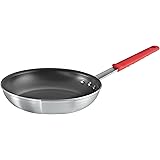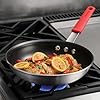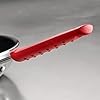CAROTE 19pcs Pots and Pans Non Stick, Cookware Sets Detachable Handle, Induction Kitchen Pots and Pans,NonStick Cooking Set, Oven/Dishwasher/Fridge Safe, Space Saving
$99.99 (as of December 6, 2025 13:01 GMT -05:00 - More infoProduct prices and availability are accurate as of the date/time indicated and are subject to change. Any price and availability information displayed on [relevant Amazon Site(s), as applicable] at the time of purchase will apply to the purchase of this product.)Kusini Electric Fondue Pot Set - Chocolate Fondue Kit - Temperature Control, Detachable Serving Trays, & 4 Roasting Forks - Gift Set & Date Night Idea. Serve at Movie Night or Game Night.
37% OffTramontina Professional 10-Inch Non Stick Frying Pan, Heavy-Gauge Aluminum Skillet with Reinforced Nonstick Coating, Red Handle, Dishwasher and Oven Safe
$38.50 (as of December 6, 2025 11:12 GMT -05:00 - More infoProduct prices and availability are accurate as of the date/time indicated and are subject to change. Any price and availability information displayed on [relevant Amazon Site(s), as applicable] at the time of purchase will apply to the purchase of this product.)Material Matters
Understanding the Basics
When it comes to cookware, the material is everything. Cooks and chefs across the world swear by different materials for various reasons. Some love stainless steel for its durability and heat distribution properties, while others prefer cast iron for that unbeatable heat retention. In my kitchen, I’ve found that the choice of material can completely change the cooking experience.
For instance, if you’re looking for non-stick capabilities, consider options like Teflon or ceramic coatings. But tread carefully – treating these surfaces with respect is key to making them last. I once ruined a non-stick pan by being too rough with it. Lesson learned! It’s always a balance between what you want your food to achieve and how you’re going to treat your cookware.
There’s also the eco-friendly angle to consider. Copper, while expensive, is a stunning option that conducts heat like a dream. Many chefs invest in it despite the pricier tag because the results often speak for themselves.
Size and Shape
Choosing the Right Pieces
Choosing the right size and shape of cookware is a pivotal aspect that often gets overlooked. I remember when I first started cooking, I used to cram everything into whatever pot I had, only to end up with uneven cooking. Now, I ensure to have a range of sizes – from small saucepans to larger stock pots. It really does make a difference.
Think about what you cook most often. If you love making big family meals, a large skillet is a must-have. But if you love sauces and lighter dishes, opting for a smaller, narrower pan can be a game changer. It’s all about making your life easier and your meals better.
Another consideration is the shape. Sauté pans with straight sides are perfect for reducing sauces, while woks and rounded shapes can be fantastic for stir-frying. I’ve experimented with various shapes and have found that using the right one really elevates the dish you’re preparing.
Heat Conductivity
Understanding Heat Transfer
Now, let’s talk heat conductivity. This is an area where many home cooks struggle. Over the years, I’ve learned that not all cookware conducts heat equally. For example, when I switched from aluminum to copper for my sautéing, the difference was astonishing. Copper heats up quickly and maintains that temperature far better, allowing for precise control.
Take the time to learn how different materials behave under heat. Cast iron is fantastic for slow and steady cooking but might not be ideal if you need quick high heat. Experimenting with temperature has been a journey for me, and I’ve learned to keep my eye on the pan rather than just the heat setting.
Remember, the right choice in cookware can help avoid hot spots in pans, where some areas heat up more than others. If you ever have that issue, it’s likely time to upgrade your cookware. A little investment can save you headaches down the road!
Durability and Maintenance
Building a Long-Term Relationship
Durability is another factor I cannot overlook. Investing in quality cookware means you’ll spend less in the long run. I once bought a cheaper set of pans that I had to replace within a year due to warping and scratches. Not the best lesson to learn! High-quality stainless steel or cast iron can last you decades with proper care.
Proper maintenance is also critical. Cast iron needs to be seasoned, while non-stick requires gentle care. I’ve had to learn the hard way that certain dishwashers can be too harsh on cookware. I now hand wash my prized pots and pans, treating them like the special tools they are. This aspect of care not only prolongs their life but also enhances your cooking.
Additionally, every material has its quirks that need attention. Understanding how to care for each piece means it will serve you well. I keep a list of my cookware and their specific care instructions right on my fridge. It’s become a fun ritual for me!
Brand Reputation
Choosing Brands Wisely
Last but certainly not least, the brand can say a lot about cookware quality. I’ve learned over the years that some brands have built a solid reputation for a reason. Their longstanding presence in the market often correlates with the quality of their products. When I invest my hard-earned cash, I look for brands known for their reliability.
My favorite brands usually have a wide range of products, allowing me to expand my collection gradually without compromising on quality. Additionally, many brands come with warranties or excellent customer service, which has saved me when I’ve had questions or concerns.
I also recommend checking out reviews and chef endorsements. Getting insights from those who have used the products extensively can be incredibly beneficial. It reminds me why I trust my go-to brands – it’s about finding that balance between reputation and personal experience!
FAQs
1. What is the best material for cookware?
It really depends on your cooking style! Stainless steel is great for durability and versatility, while cast iron is perfect for heat retention. Non-stick is great for easy cleanup, but it requires a bit more care.
2. How do I know what size cookware to buy?
Think about the types of meals you prepare. If you often cook for a crowd, larger pots and pans are ideal. For solo meals or smaller portions, smaller cookware works better.
3. How can I maintain my cookware?
Maintenance varies by material. Generally, hand wash your pots and pans, avoid harsh abrasives, and make sure to follow any specific care instructions, especially for cast iron!
4. Are expensive cookware brands worth it?
In my experience, investing in quality cookware pays off. They last longer and typically improve your cooking. However, it’s important to do your research to find something that fits within your budget yet serves your needs.
5. Why is heat conductivity important?
Heat conductivity is vital for achieving the best cooking results. It affects how evenly food cooks, which can make or break a dish. Choosing the right material can help you avoid common cooking pitfalls.
